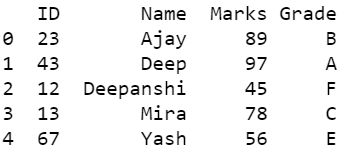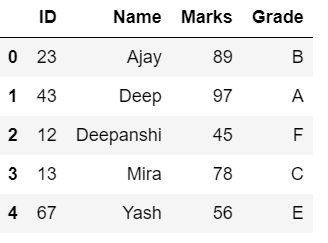如何将Pandas Dataframe保存为gzip/zip文件
Pandas是一个建立在NumPy库之上的开源库。它是一个Python包,提供各种数据结构和操作,用于处理数字数据和时间序列。它主要因导入和分析数据更容易而流行。Pandas速度很快,它对用户来说具有高性能和生产力。
转换为zip/gzip文件
Pandas中的to_pickle()方法是用来将给定的对象腌制(序列化)到文件中。这个方法利用了下面的语法。
语法:
DataFrame.to_pickle(self, path,
compression='infer',
protocol=4)
这个方法支持zip、gzip、bz2和xz等压缩方式。在给定的例子中,你会看到如何将一个DataFrame转换成zip和gzip。
例子1:将Pandas数据框架保存为zip文件
# importing packages
import pandas as pd
# dictionary of data
dct = {'ID': {0: 23, 1: 43, 2: 12,
3: 13, 4: 67},
'Name': {0: 'Ajay', 1: 'Deep',
2: 'Deepanshi', 3: 'Mira',
4: 'Yash'},
'Marks': {0: 89, 1: 97, 2: 45, 3: 78,
4: 56},
'Grade': {0: 'B', 1: 'A', 2: 'F', 3: 'C',
4: 'E'}
}
# forming dataframe and printing
data = pd.DataFrame(dct)
print(data)
# using to_pickle function to form file
# by default, compression type infers from the file extension in specified path.
# file will be created in the given path
data.to_pickle('file.zip')
输出:

示例2:将Pandas数据框架保存为gzip文件。
# importing packages
import pandas as pd
# dictionary of data
dct = {"C1": range(5), "C2": range(5, 10)}
# forming dataframe and printing
data = pd.DataFrame(dct)
print(data)
# using to_pickle function to form file
# we can also select compression type
# file will be created in the given path
data.to_pickle('file.gzip')
输出:

读取zip/gzip文件
为了读取创建的文件,你需要使用read_pickle()方法。这个方法利用了下面的语法。
pandas.read_pickle(filepath_or_buffer,
compression='infer')
示例1:读取压缩文件
# reading from the zip file
pd.read_pickle('file.zip')
输出:

示例2:读取gzip文件。
# reading from gzip file
pd.read_pickle('file.gzip')
输出:

从上面两个例子中,我们可以看到这两个压缩文件都可以被read_pickle()方法读取,除了文件扩展名之外没有任何变化。
 极客教程
极客教程